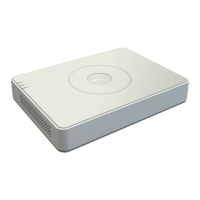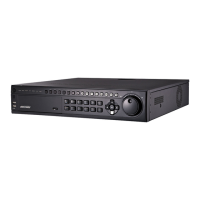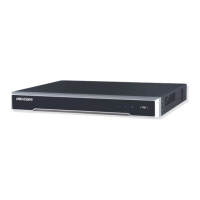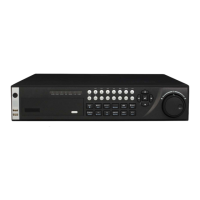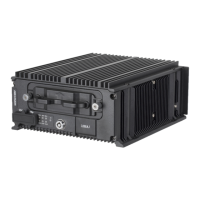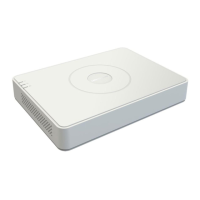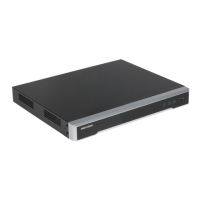Do you have a question about the HIKVISION DVR and is the answer not in the manual?
Describes the front panel components and indicators of the DVR, including power and status indicators.
Explains how to use the IR remote control for device operation, including button functions and troubleshooting.
Details how to use a USB mouse for navigation and control within the DVR interface.
Explains the soft keyboard layout and various input methods available on the device.
Details the connectors and ports on the rear panel of the DVR, such as video, audio, and network interfaces.
Provides instructions for safely powering the DVR on and off, including two shutdown options.
Guides users through initial system setup using the setup wizard for language and basic settings.
Explains the process of adding and configuring IP cameras to the DVR's connection list.
Introduces the live view feature, showing real-time video from cameras and status icons.
Covers various operations in live view mode, including screen modes, recording, and output switching.
Explains channel-zero encoding for reducing bandwidth requirements in remote viewing.
Details how to customize live view output, dwell time, audio, and camera order.
Describes how to perform manual diagnostics on analog camera video quality and view results.
Explains how to log out of the system, returning the interface to live view mode.
Guides on setting up parameters for PTZ camera control, including RS-485 settings.
Covers configuring presets, patrols, and patterns for PTZ camera movement and automation.
Describes the interface for controlling PTZ cameras, including navigation and function icons.
Details how to set encoding parameters for main and sub-streams, including resolution and bitrate.
Explains how to set up recording schedules for cameras, including daily and holiday schedules.
Configures motion detection parameters, areas, sensitivity, and response actions.
Explains how to configure recording triggered by alarm inputs and associated channels.
Describes how to manually start and stop recording for cameras without setting a schedule.
Allows setting up special recording schedules for holidays, with custom date ranges.
Explains how to enable redundant recording for enhanced data safety and reliability.
Details how to group HDDs for managing recording storage and assigning channels to groups.
Covers locking record files or setting HDDs to read-only to prevent data overwriting.
Provides methods for playing back recorded video files by channel, time, event, or tag.
Covers additional playback features like frame-by-frame viewing, smart search, and digital zoom.
Explains how to back up recorded files using USB devices, USB writers, and eSATA HDDs.
Covers management of USB flash drives, HDDs, and writers, including folder creation and formatting.
Configures motion detection parameters, areas, sensitivity, and scheduling.
Details how to configure handling methods for external sensor alarms and their schedules.
Sets up detection and response actions for video loss events, including arming schedules.
Configures detection and response for video tampering events, including sensitivity and scheduling.
Explains setting up continuous video quality diagnostics and linkage actions for exceptions.
Configures how the system handles various exceptions like HDD full or network disconnection.
Defines actions taken when an alarm or exception occurs, like full screen or email notification.
Describes how to manually trigger or clear alarm outputs for system control.
Sets up basic network parameters like IP address, DNS server, and working modes.
Covers advanced network configurations like PPPoE, EZVIZ Cloud P2P, DDNS, NTP, SNMP, NAT.
Monitors real-time network traffic information like linking status and sending/receiving rates.
Allows testing network delay, packet loss, and exporting network packets.
Explains the process of initializing a newly installed Hard Disk Drive before use.
Covers adding and configuring NAS or IP SAN disks as network HDDs for storage.
Details how to configure and manage external eSATA devices for recording or export.
Explains how to group HDDs for organized storage and management.
Allows setting storage quotas for individual cameras on HDDs to manage recorded files.
Provides methods to check the operational status of installed HDDs for maintenance.
Describes how to view S.M.A.R.T. data for HDD health monitoring and failure prediction.
Explains how to detect bad sectors on the HDD to check its condition.
Sets up alarms and response actions for HDD errors or abnormal status.
Allows customization of on-screen display elements like date, time, and camera names.
Explains how to configure privacy mask zones to obscure specific areas in the video feed.
Covers adjusting video image parameters like brightness, contrast, saturation, hue, sharpness.
Displays detailed system information about the DVR's hardware and software components.
Describes how to search, view, and export system log files for auditing and troubleshooting.
Covers exporting and importing IP camera configuration data via Excel files.
Allows backing up and restoring the DVR's configuration settings to local backup devices.
Explains how to upgrade the DVR's firmware using local backup devices or remote FTP server.
Guides on resetting the DVR's settings to factory defaults, excluding network parameters.
Details configuration of the RS-232 serial port for parameter transfer or transparent channel.
Covers general system settings like language, resolution, time zone, and mouse pointer speed.
Explains how to configure Daylight Saving Time (DST) settings for automatic adjustment.
Covers additional settings like device name, auto logout, and menu output mode.
Covers adding, deleting, and editing user accounts and their operational permissions.
Explains how to log out, shut down, or reboot the DVR from the shutdown menu.
Provides definitions of technical terms and acronyms used throughout the manual.
Offers solutions to common problems encountered with the DVR, such as no image or beep sounds.
Lists IP cameras compatible with the DVR, including model and version details.
Describes the front panel components and indicators of the DVR, including power and status indicators.
Explains how to use the IR remote control for device operation, including button functions and troubleshooting.
Details how to use a USB mouse for navigation and control within the DVR interface.
Explains the soft keyboard layout and various input methods available on the device.
Details the connectors and ports on the rear panel of the DVR, such as video, audio, and network interfaces.
Provides instructions for safely powering the DVR on and off, including two shutdown options.
Guides users through initial system setup using the setup wizard for language and basic settings.
Explains the process of adding and configuring IP cameras to the DVR's connection list.
Introduces the live view feature, showing real-time video from cameras and status icons.
Covers various operations in live view mode, including screen modes, recording, and output switching.
Explains channel-zero encoding for reducing bandwidth requirements in remote viewing.
Details how to customize live view output, dwell time, audio, and camera order.
Describes how to perform manual diagnostics on analog camera video quality and view results.
Explains how to log out of the system, returning the interface to live view mode.
Guides on setting up parameters for PTZ camera control, including RS-485 settings.
Covers configuring presets, patrols, and patterns for PTZ camera movement and automation.
Describes the interface for controlling PTZ cameras, including navigation and function icons.
Details how to set encoding parameters for main and sub-streams, including resolution and bitrate.
Explains how to set up recording schedules for cameras, including daily and holiday schedules.
Configures motion detection parameters, areas, sensitivity, and response actions.
Explains how to configure recording triggered by alarm inputs and associated channels.
Describes how to manually start and stop recording for cameras without setting a schedule.
Allows setting up special recording schedules for holidays, with custom date ranges.
Explains how to enable redundant recording for enhanced data safety and reliability.
Details how to group HDDs for managing recording storage and assigning channels to groups.
Covers locking record files or setting HDDs to read-only to prevent data overwriting.
Provides methods for playing back recorded video files by channel, time, event, or tag.
Covers additional playback features like frame-by-frame viewing, smart search, and digital zoom.
Explains how to back up recorded files using USB devices, USB writers, and eSATA HDDs.
Covers management of USB flash drives, HDDs, and writers, including folder creation and formatting.
Configures motion detection parameters, areas, sensitivity, and scheduling.
Details how to configure handling methods for external sensor alarms and their schedules.
Sets up detection and response actions for video loss events, including arming schedules.
Configures detection and response for video tampering events, including sensitivity and scheduling.
Explains setting up continuous video quality diagnostics and linkage actions for exceptions.
Configures how the system handles various exceptions like HDD full or network disconnection.
Defines actions taken when an alarm or exception occurs, like full screen or email notification.
Describes how to manually trigger or clear alarm outputs for system control.
Sets up basic network parameters like IP address, DNS server, and working modes.
Covers advanced network configurations like PPPoE, EZVIZ Cloud P2P, DDNS, NTP, SNMP, NAT.
Monitors real-time network traffic information like linking status and sending/receiving rates.
Allows testing network delay, packet loss, and exporting network packets.
Explains the process of initializing a newly installed Hard Disk Drive before use.
Covers adding and configuring NAS or IP SAN disks as network HDDs for storage.
Details how to configure and manage external eSATA devices for recording or export.
Explains how to group HDDs for organized storage and management.
Allows setting storage quotas for individual cameras on HDDs to manage recorded files.
Provides methods to check the operational status of installed HDDs for maintenance.
Describes how to view S.M.A.R.T. data for HDD health monitoring and failure prediction.
Explains how to detect bad sectors on the HDD to check its condition.
Sets up alarms and response actions for HDD errors or abnormal status.
Allows customization of on-screen display elements like date, time, and camera names.
Explains how to configure privacy mask zones to obscure specific areas in the video feed.
Covers adjusting video image parameters like brightness, contrast, saturation, hue, sharpness.
Displays detailed system information about the DVR's hardware and software components.
Describes how to search, view, and export system log files for auditing and troubleshooting.
Covers exporting and importing IP camera configuration data via Excel files.
Allows backing up and restoring the DVR's configuration settings to local backup devices.
Explains how to upgrade the DVR's firmware using local backup devices or remote FTP server.
Guides on resetting the DVR's settings to factory defaults, excluding network parameters.
Details configuration of the RS-232 serial port for parameter transfer or transparent channel.
Covers general system settings like language, resolution, time zone, and mouse pointer speed.
Explains how to configure Daylight Saving Time (DST) settings for automatic adjustment.
Covers additional settings like device name, auto logout, and menu output mode.
Covers adding, deleting, and editing user accounts and their operational permissions.
Explains how to log out, shut down, or reboot the DVR from the shutdown menu.
Provides definitions of technical terms and acronyms used throughout the manual.
Offers solutions to common problems encountered with the DVR, such as no image or beep sounds.
Lists IP cameras compatible with the DVR, including model and version details.
